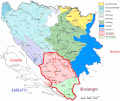Vrbas (river)
| Vrbas Врбас | |
|---|---|
 Vrbas River in Bosnia and Herzegovina  | |
| Location | |
| Country | Bosnia and Herzegovina |
| Physical characteristics | |
| Source | |
| • location | Vranica |
| Mouth | |
• location | Sava |
• coordinates | 45°06′29″N 17°30′50″E / 45.108°N 17.514°ECoordinates: 45°06′29″N 17°30′50″E / 45.108°N 17.514°E |
| Length | 249.7 km (155.2 mi) [1] |
| Basin size | 6,274 km2 (2,422 sq mi) [1] |
| Basin features | |
| Progression | Sava→ Danube→ Black Sea |
The Vrbas (Serbian Cyrillic: Врбас, pronounced [ʋr̩̂bas]) is a major river with a length of 250 kilometres (160 mi), in western Bosnia and Herzegovina. It is a right tributary of the Sava river. The city of Banja Luka is located on the river banks.[2][3][4][5]
Name[]
The word vrba means 'willow' in Serbo-Croatian, and a number of weeping willow trees adorn the river banks in Banja Luka.
It lent its name to one of the provinces (banovinas) of the Kingdom of Yugoslavia, the Vrbas Banovina.
Geography[]
It is a right tributary of the river Sava. The Vrbas river appears at the southern slope of the Vranica mountain near the town of Gornji Vakuf, at around 1,530 metres (5,020 ft) above sea level and it drains central part of the northern slopes of the Dinaric mountain massif. It empties into the Sava river at around 90 metres (300 ft) above sea level. Total length of the main watercourse is around 250 kilometres (160 mi).
Climate[]
Average annual rainfall is around 800 L/m2 at the mouth of the Vrbas to the Sava river and up to 1500 L/m2 in the southern part of the basin. Characteristic mean flow is around 34.6 L/s/km2 Maximum rainfall occurs in the southern parts of the Vrbas basin in the late autumn and winter months, with minimum quantities in summer, whereas the northern parts of the basin receive the largest quantities of rain during the summer months (June–July), with the maximum in November and December.
Tributaries[]
The most important right tributaries are the Desna river, the Ugar, and the Vrbanja, and left: Prusačka river, Semešnica, the Pliva, the (Black River), and the Suturlija, which are located in the middle part of the basin.[6]
Gallery[]

Near Banja Luka


The river
See also[]
- Gornji Vakuf
- Bugojno
- Donji Vakuf
- Jajce
- Banja Luka
References[]
- ^ Jump up to: a b "Sava River Basin Analysis Report" (PDF, 9.98 MB). International Sava River Basin Commission. September 2009. p. 13. Retrieved 2018-05-18.
- ^ Vojnogeografski institut, Ed. (1955): Travnik (List karte 1:100.000, Izohipse na 20 m). Vojnogeografski institut, Beograd.
- ^ Spahić M. et al. (2000): Bosna i Hercegovina (1:250.000). Izdavačko preduzeće „Sejtarija“, Sarajevo.
- ^ Mučibabić B., Ed. (1998): Geografski atlas Bosne i Hercegovine. Geodetski zavod BiH, Sarajevo.
- ^ [1]
- ^ http://www.hesvrbas.com/eng/
| Wikimedia Commons has media related to Vrbas River. |
- Tributaries of the Sava
- Vrbas basin
- Rivers of Bosnia and Herzegovina
- Bosnia and Herzegovina river stubs




